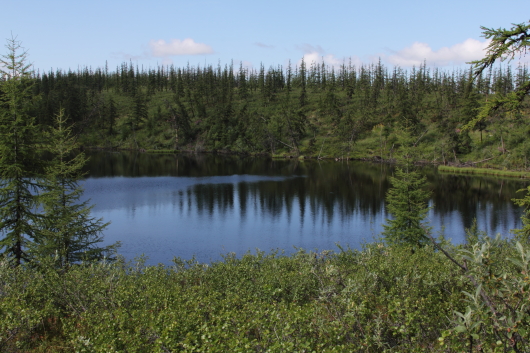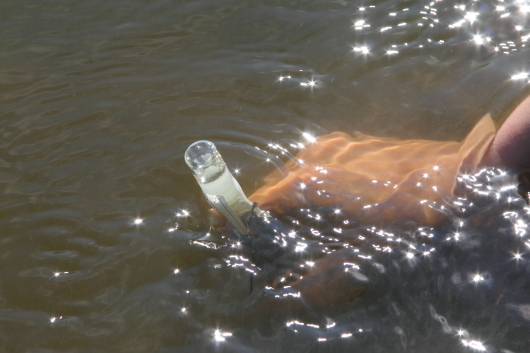Today Eirik and I carried the inflatable boat down the dirt path towards Lake Shuchi (Pike’s Lake). We turned right at the tipped over, rusty green refrigerator — a perfect road sign — and past the crumbling orange insulated building condemned by the town of Cherski. We threw down our gear in a swarm of unrelenting mosquito attacks amd used a tiny footpump to pump the rubber boat. We carried it down the hill, through thick brush and rusting Russian beer cans and barrels to the shore of the thermokarst lake. These lakes form when fires or heavy rains pool water and disturb the ground. This small pool of water thaws the permafrost beneath the surface, forming a layer called a talik. This means the bottom isn’t solid, and as such the lakes actually move about 10 centimeters a year.

Still as glass, Shuchi Lake reflects the trees and sky as it rests in the midst of the verdant green larch forest. As well as presenting a lovely landscape, Shuchi Lake has been the subject of many scientific studies related to exhalation of methane from deep below its surface. © Becky Tachihara
In the bottom of most lakes, dissolved oxygen approaches anoxia — zero milligrams per liter (it was 0.05 milligrams per liter in Lake Shuchi yesterday). This is because a combination of physical and biological processes. Air is constantly being absorbed into the water of the lake. This is good for the oxygen breathers. The dissolved oxygen moves downward through diffusion, but can only get so far before most of it is used up by organisms (past what limnologists call the thermocline, about 3 meters below the surface yesterday). Breathers need to get a bit more creative near the bottom. That’s where methane comes in. The freshly thawed organic matter from the talik is tasty microbe food, a complex mixture of biomass. Without oxygen, they cannot exhale carbon dioxide like us, instead they exhale methane, which rise to the surface in bubbles that look deceivingly like fish.
I sat floating tranquilly, with Eirik dipping in a probe to measure acidity, temperature, and oxygen every half meter and taking water samples. Thoughts drifted to flies and flyfishing, and our conversation bubbled with excitement as we started to see rise after rising fish.

Laurel uses a funnel and glass vials to collect samples of methane bubbling up from the bottom of a stream. Tracking the methane coming out of lakes and streams is a key part of accounting for Arctic carbon stocks. © Becky Tachihara
In the bowl of this Siberian thermokarst lake, surrounded by rich green of moss shrubs and boreal forest, methane rises far more often than fish, which is much more exciting than fish for the carbon cycle. We paddled around the boat, using a paddle each like a canoe near hotspots of bubbling (this ebullition happens 24 hours a day).
Look at Cherski on google maps, look at how many lakes there are to the east. Get excited about fish, but be conscious of the methane bubbling out of lakes all over the arctic. As the climate warms, these taliks will form more rapidly, increasing methane release from lake bottoms, and creating further climate warming. Your friend may give you positive feedback on catching a nice lake trout, but the positive feedback of methane release from thermokarst lakes is a significant source in the global methane budget.



